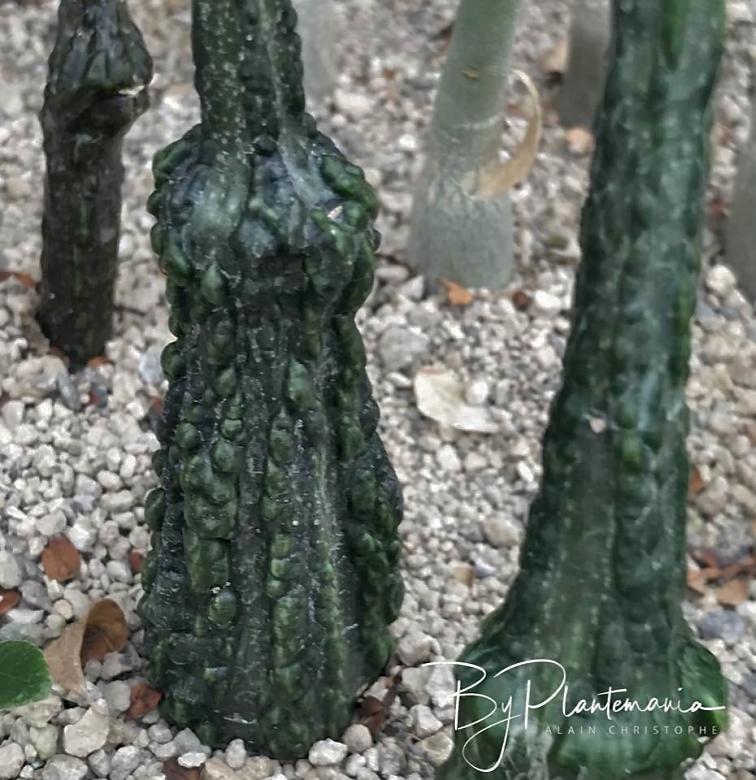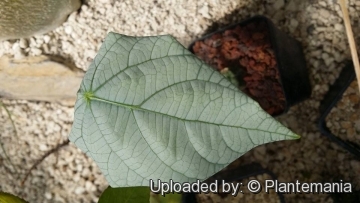
Adenia epigea Photo by: © Plantemania
Origin and Habitat: NE Madagascar (Plateaux de l'Ankarana).
Altitude range: Up to 100 metres above sea level.
Habitat and ecology: Adenia epigeaSN|33454]]SN|33454]] grows in dry forest on gneiss or volcanic rocks, at low altitude. They ae often found growing together with other ‘lumps’ such as Cyphostemma pachypusSN|33422]]SN|33422]] and Euphorbia ankaranensis. The other euphorbia frequently encountered in this area is Euphorbia pachypodioides.
Synonyms:
Description: Adenia epigea is is a slow growing large, deciduous, succulent liana up to 5 m long noted for the huge conical or rounded above-ground caudex it produces, and caudices often deformed and monstrous with diameters exceeding 1 m are well documented. What former have been known as "The Red Form" is actually Adenia firingalavensis var. stylosaSN|33454]]SN|28284]] which have been raised to its own species by David John Hearn in 2007: Adenia stylosaSN|28282]]SN|28282]].
Caudex: The swollen above-ground tuberous base of stem, also know as caudex, ranging in shape from round, globular, conical, flattened or irregular, semi-woody and often reaching up to one metre in diameter, abruptly narrowed at the top in a much-branched, cylindrical stems are 5–10 cm thick from which emerge, glabrous, deciduous vines (branches) up to 5 m long with tendrils 5-10 cm long. Without waxy coating either on the caudex or on the stem or its branches.
Leaves: Deeply 3-lobed, broadly ovate in outline, 2.5 5 cm long, 3-6 cm wide, margin entire. Medial lobe oval-triangular and obtuse at the apex, the laterals more acute. Petiole 1.5-7 cm long longer than the leaf-blade, without glands, the two glands being carried by the thickened anterior border of the blade. Tendrils simple, axillar usually associated with the inflorescence.
Inflorescence (small cymes): Usually on the upper third of the vines, male infloersceces each bearing 2- to 5-flowers, female inflorescences reduced to 1-2 flowers. Bracts reddish, small, narrow and deciduous. Rudimentary leaves small, reduced to a short petiole, with 2 glands and a rudiment of limb, inserted at the base of the tendrils-inflorescences. Tendril 2-4.5 cm long. Peduncle 4-7 cm long. Pedicels, 5,5-6 mm long.
Male flowers: Receptacle tubular to narrowly funnel-shaped, including stipe 25-28 mm long. Calix tube absent. Sepals lanceolate 8-10 mm long. Petal white oblong, obtuse, 6-7 mm long. Filaments free at the top for over 1 mm, united to the receptacle tube along its entire length. Anthers 7 mm long. Corona of minute fleshy appendages. Nectar-glands absent.
Female flowers: 11-15 mm long on very short pedicel (1-2 mm). Tubular receptacle, very short (3 mm.) Sepals 7 mm long, petals as long, white. Ovary ovoid-oblong, 3 -3.5 mm long. Styles united for c. 4 mm, subglobose, woolly, each 1 mm in diameter.
Fruit: Solitary, elongated elongate fusiform (attenuated towards the two extremities), about 13 cm long and 3 cm in diameter. Pericarp (skin) thinly coriaceous, smooth.
Seeds: About 50 per fruit, suborbicular, 5-6 x 4-5 mm strongly bordered..
Related species. Adenia epigeaSN|28284]]SN|33454]] is close to Adenia monadelpha but distinct by the long slender fruit.
Bibliography: Major references and further lectures
1) H.Humbert “Flore de Madagascar et des Comorres” 143th family – Passifloraceae, by H. Perrier de la Bathie 1945
2) Urs Eggli “Illustrated Handbook of Succulent Plants: Dicotyledons” Springer Science & Business Media, 2002
3) Adenia epigea in: Cactus and Succulent Journal - Volume 79, 2007
4) Bihrmann's caudiciforms “Adenia epigea” web <http://www.bihrmann.com/caudiciforms/subs/ade-epi-sub.asp>
5) Hilary Bradt, Daniel Austin “Madagascar” Bradt Travel Guides, 01 July 2014
6) Adenia epigea in: Adansonia, Volume 10 Muséum National d'Histoire Naturelle, Laboratoire de phanérogamie, 1970
7) Al Laius “Like it or lump it Madagascan caudiciforms” Essex Succulent Review Volume 53 Number 3 September 2016
 Adenia epigea Photo by: © Plantemania
Adenia epigea Photo by: © PlantemaniaSend a photo of this plant.The gallery now contains thousands of pictures, however it is possible to do even more. We are, of course, seeking photos of species not yet shown in the gallery but not only that, we are also looking for better pictures than those already present.
Read More...











